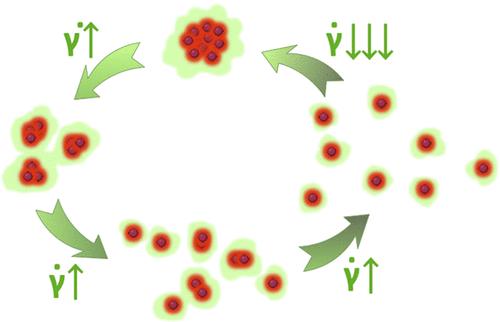树突蛋白纳米涂层:具有剪切控制厚度和渗透性的基底不可知、自组装结构
IF 3.9
2区 化学
Q2 CHEMISTRY, MULTIDISCIPLINARY
引用次数: 0
摘要
本研究研究了杂化聚胺胺肽树状大分子(DendriPeps)的自组装成具有纳米厚度的剪切响应囊泡状结构,称为“纳米涂层”,能够封装纳米和微观尺度的颗粒。为了评估树突pep与材料无关的涂层能力,我们测试了在各种合成和生物基质上形成纳米涂层的情况,包括聚苯乙烯纳米颗粒、聚(n -异丙基丙烯酰胺)微凝胶、镓铟液态金属纳米液滴、噬菌体和慢病毒。具体来说,我们利用光谱和显微技术来监测纳米涂层在控制周围水相剪切应力的情况下在颗粒表面的可逆组装。此外,我们评估了纳米涂层作为胶剂的使用,介导颗粒团簇的形成,其大小,就颗粒数量和涂层厚度而言,可以通过调节剪切应力来动态控制。最后,我们利用树突pep纳米涂层的可重构性来开发用于剪切控制的生物活性有效载荷递送的载体。为此,我们通过施加0.5-1 Pa的剪切应力,实现了抗菌肽多粘菌素B从树突pep包被的微凝胶中可控释放。这些结果证明了DendriPeps在生物医学应用中利用局部剪切梯度开发可重构系统的潜力。本文章由计算机程序翻译,如有差异,请以英文原文为准。

DendriPep Nanocoats: Substrate-Agnostic, Self-Assembling Constructs with Shear-Controlled Thickness and Permeability
This study investigates the self-assembly of hybrid poly(amidoamine)-peptide dendrimers (DendriPeps) into shear-responsive vesicle-like structures with nanometric thickness, called “Nanocoats”, that are capable of encapsulating nano- and microscale particles. To assess the material-agnostic coating power of DendriPeps, we tested the formation of Nanocoats on a variety of synthetic and biological substrates, including polystyrene nanoparticles, poly(N-isopropylacrylamide) microgels, gallium–indium liquid metal nanodroplets, and bacteriophages and lentiviruses. Specifically, we utilized spectroscopic and microscopic techniques to monitor the reversible assembly of Nanocoats on the surface of the particles upon controlling the shear stress of the surrounding aqueous phase. Furthermore, we evaluated the use of Nanocoats as a glue mediating the formation of particle clusters, whose size, in terms of the number of particles and coating thickness, can be dynamically controlled by adjusting the shear stress. Finally, we harnessed the reconfigurability of DendriPep Nanocoats to develop vectors for the shear-controlled delivery of a bioactive payload. To that end, we achieved the controlled release of the antibacterial peptide polymyxin B from DendriPep-coated microgels by applying shear stresses of 0.5–1 Pa. These results demonstrate the potential of DendriPeps to develop reconfigurable systems for biomedical applications that leverage localized shear gradients.
求助全文
通过发布文献求助,成功后即可免费获取论文全文。
去求助
来源期刊

Langmuir
化学-材料科学:综合
CiteScore
6.50
自引率
10.30%
发文量
1464
审稿时长
2.1 months
期刊介绍:
Langmuir is an interdisciplinary journal publishing articles in the following subject categories:
Colloids: surfactants and self-assembly, dispersions, emulsions, foams
Interfaces: adsorption, reactions, films, forces
Biological Interfaces: biocolloids, biomolecular and biomimetic materials
Materials: nano- and mesostructured materials, polymers, gels, liquid crystals
Electrochemistry: interfacial charge transfer, charge transport, electrocatalysis, electrokinetic phenomena, bioelectrochemistry
Devices and Applications: sensors, fluidics, patterning, catalysis, photonic crystals
However, when high-impact, original work is submitted that does not fit within the above categories, decisions to accept or decline such papers will be based on one criteria: What Would Irving Do?
Langmuir ranks #2 in citations out of 136 journals in the category of Physical Chemistry with 113,157 total citations. The journal received an Impact Factor of 4.384*.
This journal is also indexed in the categories of Materials Science (ranked #1) and Multidisciplinary Chemistry (ranked #5).
 求助内容:
求助内容: 应助结果提醒方式:
应助结果提醒方式:


